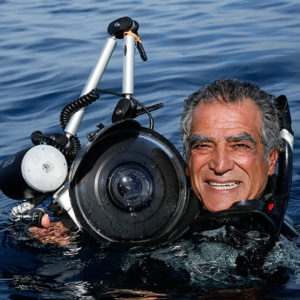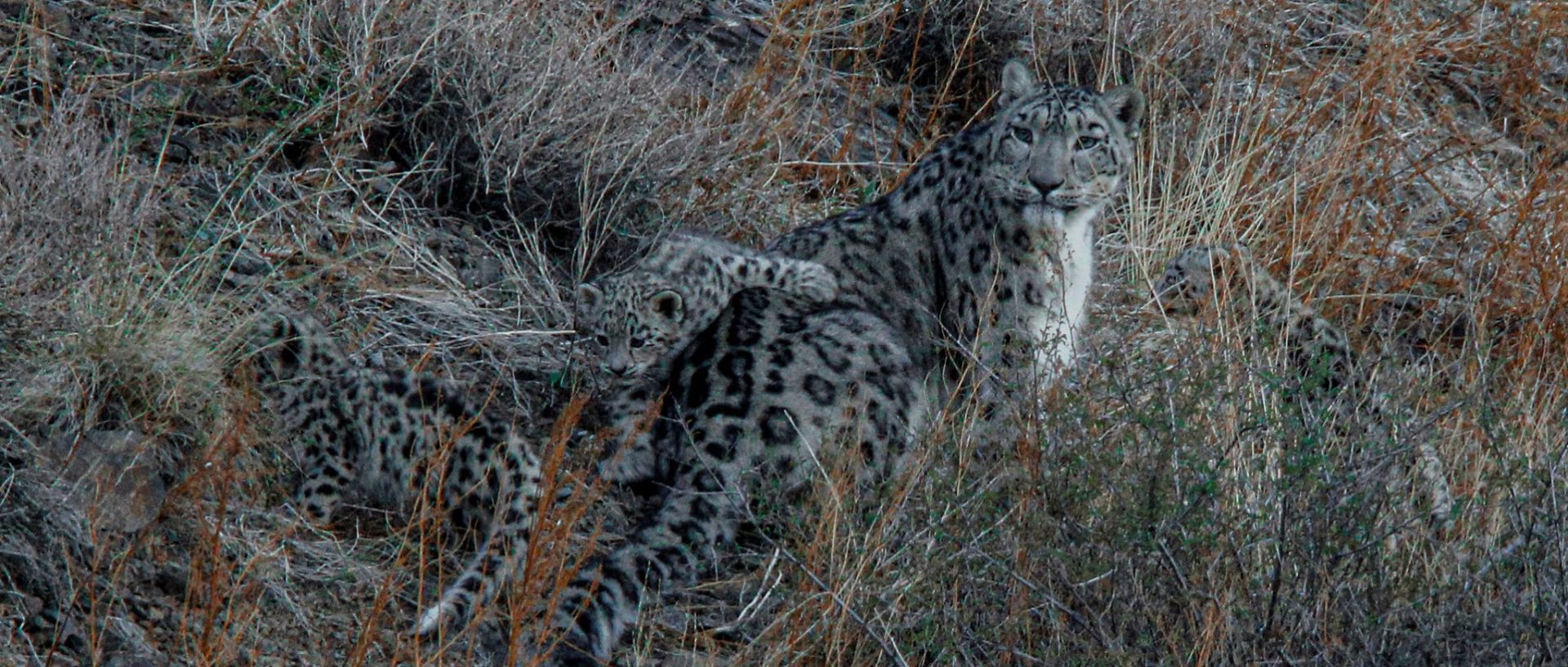Snow Leopards in Mongolia
Peak Season:
January — February
Mongolia
Charter Length:
12 Days
4 Explorers
Expedition Overview
In 2014, Amos led his most successful snow leopard photography expedition to date—not to Mongolia—but to Ladakh, India. His images of snow leopards were stunning, earning him multiple wildlife photography awards and nominations. After that expedition, he operated two more trips successfully, but in recent years Ladakh has become a popular travel destination and the mountain has become overcrowded.
That brings us to Mongolia where, back in 2010, Amos first started thinking about snow leopards. He was there to photograph the Golden Eagle festival but was intrigued by local reports of “ghost cats.” He set out to find them, and although he had some success, his efforts revealed challenges with tracking and infrastructure that made further expeditions impractical at that time.
Now in 2021, Mongolia has become a very promising and practical location for finding these elusive cats. This is thanks to local guides like Baatar Navaan and his team, who’ve been hard at work over the years developing advanced tracking techniques and improving expedition logistics.
Amos is returning to Mongolia with four of you, wildlife photographers and adventurers, in the Winter of 2021. You will be in a great position to capture some rare images of snow leopards traveling, hunting and nursing against the white snow.
Send Me More Information
Expedition Leader

Amos Nachoum is a distinguished figure in wildlife and underwater photography, with a remarkable career spanning over four decades. His unique ability to blend exploration and artistry has captured the attention of audiences worldwide, with his work being prominently featured in esteemed publications such as National Geographic and The New York Times.
His talents have earned him numerous accolades, including the prestigious BBC Wildlife Photographer of the Year award, received twice in recognition of his unparalleled skill and commitment. Amos is the founder of Big Animals xpeditions, inviting adventurers to join him on extraordinary journeys to witness the majesty of wildlife in both marine and terrestrial environments.
His 2019 documentary, “Picture of His Life,” highlights his relentless pursuit of excellence and undying passion for wildlife photography. It chronicles his quest to photograph a swimming polar bear in the Canadian Arctic, showcasing his ability to connect with nature’s most magnificent creatures.
Joining Amos on an expedition transcends the ordinary adventure; it is a profound learning experience, an opportunity to immerse oneself in the beauty of the natural world, under the guidance of a master photographer. His work serves as a powerful reminder of the importance of preserving the planet’s incredible biodiversity. Amos Nachoum’s expeditions are a celebration of wildlife, a journey of discovery and appreciation, from the depths of the oceans to the far reaches of the mountains.
Location
Sample Itinerary
Day 1. Arrival, Ulaanbaatar
Arrive in Ulaanbaatar, the capital of Mongolia. A center of an emerging economy, this city is where nomadic civilization and metropolitan life style meet. We will be welcomed by our Mongolian Outdoor Travel guide and will then travel downtown to the hotel (30 minutes away). After we are settled, there will be a welcome dinner at a Mongolian style restaurant.
Day 2. Western Saikhan Mountain / Saikhan Devseg Valley
After breakfast, we will start our trip to the south Gobi province, stopping on the way at a town called Mandalgobi for lunch (3 hours). Then, we will continue to drive south to the Saikhan Devseg Valley of the West Saikhan Mountain (4-5 hours). In the evening, we will stop at the Dalanzadgad Overnight area and camp in yurts.
Days 3-12. West Saikhan Mountain / Saikan Devseg Valley
We will spend these ten full days in the Saikhan Devseg valley and its surrounding hills. Our daily routes will go through mountain trails, as we follow local herdsmen and their livestock. All of our attention will be focused on finding and
photographing the elusive snow leopard. The valley circles the West Saikhan Mountain, which stands at 2000 meters in height. One side of the mountain is more snowy and shady, and may contain more slippery trails associated with packed snow and rock boulders. We will all work together while hiking and make sure everyone is safe and secure. Each day will go as follows:
- We start our daily hikes between 8 and 9am, return 5 pm
- Packed lunches will be provided during hiking days, and each day we will hike and explore different parts of the valley based on territorial markings, traces, pugmarks, and scats
- We will set up motion sensor cameras in several areas and use their data to help in our search
Each yurt is equipped with folding beds with mattresses, as well as working stoves. Each of us will have 3 seasonal, wide cotton coveted sleeping bags. The facilities we will be surrounded by have field WCs with closures and seats, wash sinks, and buckets of hot water. Every evening we will enjoy dinner made by a local field cook and discuss the next day’s plans. To maximize our immersion into Mongolian culture, on some days we will drive to a nearby village to photograph the local monastery as well as the local camel herders.
Day 13. Ulaanbaatar
We will say farewell to the local crew and start our return to Ulaanbaatar. We will stop once again at Mandalgobi
for a quick lunch and then later in the afternoon return to the hotel.
Day 14. Departure
After breakfast, we will transfer to the airport for our departure
Conditions
Temperature
Daily Highs: 2° F / -16° C
Daily Lows: -17° F / -27°C
Cloud Cover
45% chance Overcast+
Precipitation
1% chance of precipitation
Sun
8H 41M on Dec 1
Previous Accommodations
2 nights hotel in Ulanbaatar, Kempinski Hotel
Yurt
Included
- Expedition Leadership
- Ground transportation as indicated in the itinerary (based on a 4×4 Jeep)
- Two nights stay in Ulaanbaatar, Kempinski Hotel
- Ten days searching and filming snow leopards
- Eleven nights Yurt accommodations
- All Meals and Field chef
- Support animals
- Airport transfers, national park fee, motion cameras, generators, Wi-Fi at the camp
Excluded
- Travel to Mongolia
- Meals and activities in Ullanbbaatar
- Insurance, travel and medical
- Wifi and phone fees, alcoholic drinks
- Gratuities
What more can We tell you?
More Details
This “ghost cat” is renowned for its grey, spotted coat, and lives throughout many of the mountain ranges across Asia. A rare sight to see, these cats hold an important, sometimes even mystical, place in local communities. Recently, however, these cats have seen their population decline due to habitat loss and poaching. As a result, many countries have instituted conservation laws in order to protect this animal, which holds an important place in many cultures. Much of the money that goes into this trip will go into the local economy to bolster growth and aid in conservation efforts.
There will be private tents to return to after each day of trekking, so that everyone can relax and recharge for the next day’s adventures. These sleeping quarters, called Yurts, are traditional Central Asian rounded tents that are covered in skins or felt. Not only are the Yurts nice and cozy, but they will also give you a chance to soak in even more of the native culture of the region during your stay. You must be in good physical condition, strong minded, and a team player. This is a unique opportunity to practice working with the extreme telephoto lenses (600mm or 800mm), and everyone will be working shoulder to shoulder the whole journey.
To support daily hiking in the mountainous environment, there will be a few horses to carry our lenses, cameras, and tripods, as well as extra warm cloth, food and other emergency supplies for your comfort and safety. While this expedition will surely be a challenge, those who are hungry for discovery will no doubt be rewarded with both incredible pictures and memories that last a lifetime
Workshop Video
More Workshops
Products Not Found

